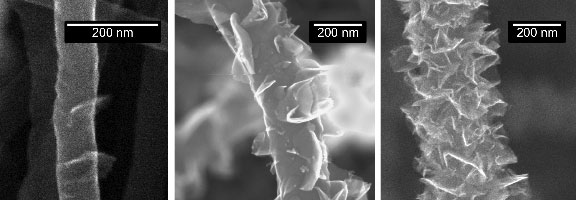Planet Nano
Today, we visit Planet Nano. The University of Houston's College of Engineering presents this series about the machines that make our civilization run, and the people whose ingenuity created them.
Welcome to Planet Nano! Scientists and engineers are now making nanostructures with increasingly exotic shapes. These are very, very tiny structures — a millionth to a billionth of a meter in size. They can look like ribbons, combs, fish bones, skeletons, nails, bridges, windmills, branches and forests.

Scanning Electron Microscopy (SEM) of carbon nanotubes with graphene branches [Wikipedia, BRStoner]
Let's get a feel for this small scale. Imagine that we magnify our hair thickness to the size of a football field. The size of these nanostructures compared to our hair thickness is similar to the size of a football in that field. These tiny materials are essentially invisible to the naked eye — almost impossible to see under a light microscope. We see them onlyunder an electron microscope.
Remember the days when a tiny carbon sphere with a size of a billionth of a meter called a "bucky ball" was a huge discovery? Kroto, Heath, Curl, O'Brien and Smalley initiated the path for more discoveries and developments in the field of nanomaterials. Now, we are making all kinds of complex forms at nanoscale — a billionth of a meter.

Buckminsterfullerene or "buckyball" C60 (lower left) and carbon nanotube (upper right) [Wikipedia]
Similar trends are occurring everywhere. The days when every actor's skin looks perfect on the TV screen are over. Now, on high definition TV we can see the smallest details of skin, hair and more — not all complimentary. In high definition TV, details are controlled as much as possible — sometimes naturally and other times at the hands of a good makeup artist or post-photo-editor.
In the nano-material world, we can also see nanoparticles down to their smallest details, and the good news is that we can make and control those details. This in itself is a great human achievement. But there is much more to these nanomaterials.

Mesoporous silica (silicon dioxide) nanoparticles of various diameters (a)-(c) Transmission Electron Microscopy (TEM) images (d) Scanning Electron Microscopy (SEM) image [Wikipedia/Nandiyanto]
Because of their unique properties like high surface to volume ratio and nanoscale dimensions, these tiny materials are finding important practical applications. They can be used in cutting edge electronics, energy harvesting, energy storage, medicine and biotechnology among others.
And speaking of nano-forests, nano-skeletons and nano-fish bones, we may visualize tiny cities, jungles and oceans with their nano-objects. It's a world of small things. It's Planet Nano and we've just made a visit.
I'm Haleh Ardebili at the University of Houston, where we're interested in the way inventive minds work.
Reference: Lao, JY, Wen, JG, Ren, ZF, 'Hierarchical ZnO Nanostructures', Nano Letters, Vol. 2, No. 11, pp 1287-1291, 2002
This episode was first aired on February 18, 2013.